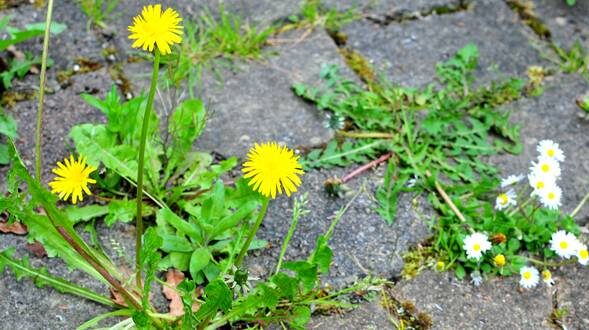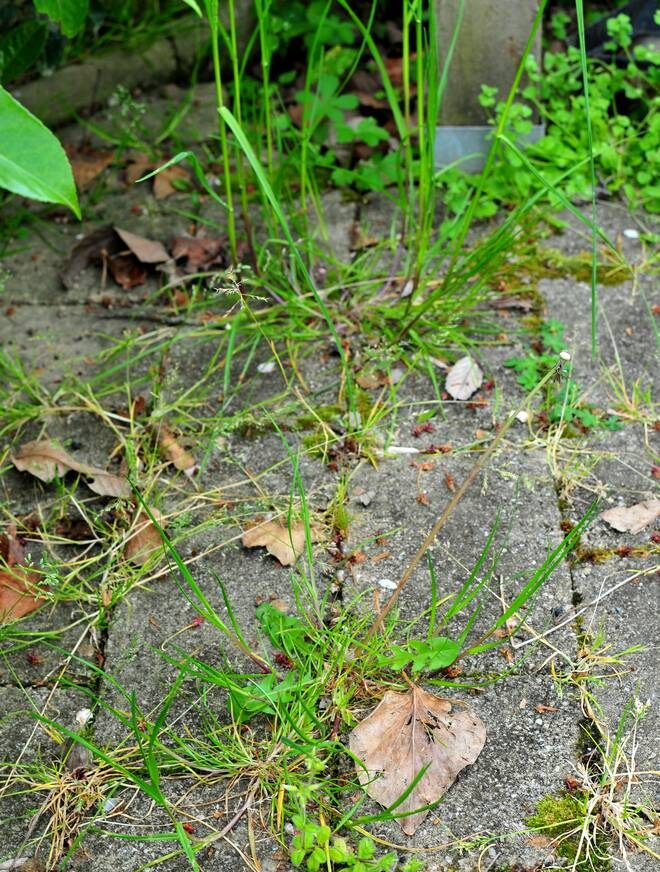
Since January 1 , 2019 , the sale of glyphosate is indeed prohibited for individuals . This herbicide molecule , whose health hazard has been proven, is the main component of weedkillers such as RoundUp . Now only farmers are still allowed to use it, at their own risk , but for how long? On the garden side, we must now learn to do without glyphosate. So here is a spotlight on a battery of credible alternatives for weeding naturally.
Cultivate, hoe: the effectiveness of elbow grease!
Do not believe in an unwelcome provocation! The best natural weedkiller is – and will remain – elbow grease ! We bend down, push a screwdriver into the ground near the roots, and we tear it out! Effective, natural and economical! Except for the back maybe?
Equipped with a fixed blade, the weeder is also extremely effective. It allows you to cut the seedlings at their base. When they are barely emerging, weeds are indeed easier to eliminate than once rooted. Regular, rapid weeding therefore avoids having to use a hoe, which is heavier and more tedious.
If they haven’t had time to flower and then go to seed, you can leave the rooted or hoeed plants to dry on the ground. Throw the others in the compost heap. The rise in temperature during fermentation will eliminate their seeds.
Cover, deprive of light
If your garden is invaded by bindweed, you will have to tear and tear, they will come back at a gallop because each piece of root left in the ground inevitably cuts and produces a new plant! The best weedkiller to eliminate these bindweed , as with other equally recalcitrant and invasive plants, is to cover the ground. Deprived of light, everything below can no longer germinate or develop. Seedlings that have already emerged suffocate and will not grow back. What can be used?
Lay a tarp
Not very ecological, black plastic is still often used in the garden, especially for multi-year crops: at the foot of strawberries, raspberries, squash, tomatoes or even certain shrubs. We frankly advise against it because, in addition to its ecological impact, this waterproof and airtight film sterilizes the soil in the long run!
Instead, biodegradable blankets or tarps made from cornstarch or woven fabrics that last for several years can be used.
Recycle cardboard
Our volume of waste to be recycled has exploded in recent years. So here’s a way to use the cardboard boxes that you’re trying to get rid of, provided they don’t bear any inscriptions (inks are toxic to soil microorganisms).
Spread them over empty areas of the vegetable garden, at the foot of established or just transplanted vegetables, shrubs… It’s simple and effective. Unfortunately, some gardeners do not like this cover, which they consider not very beautiful!
Mulch, and more mulch!
A good mulch doesn’t just smother budding weeds. It also protects the soil from rapid leaching, compaction and saves irrigation water.
Many mulches can be used to limit weed control, in layers at least 5 cm thick:
- organic materials: dried grass clippings (mulch), straw, cocoa pods, flax and hemp flakes, pine bark, wood shavings, etc. Spread at the base of many plants and regularly renewed, they stimulate the life of the soil and allow you to replenish your humus reserves.
- mineral materials: fragments of pottery, tiles or broken slates, gravel… These materials are inert: they add nothing to the soil. They are therefore mainly used to cover an aisle.
Pelargonic acid, the natural weedkiller
In Nature, almost everything is already there, including plants capable of preventing others from growing. We are therefore inspired by it to make natural weedkillers.
On the shelves of garden centres, we have seen the flowering of organic weedkillers based on pelargonic acid . It is a substance that is found naturally in pelargoniums and which therefore inspired engineers to weed other than with glyphosate.
As much to say it right away, pelargonic acid, we have seen more effective! This type of organic weedkiller works fairly well on young annual plants such as chickweed for example. On the other hand, when it comes to well-established or particularly recalcitrant perennials, the effect obtained is close to zero! If we add to that that the bottle is overpriced compared to its effectiveness, only one piece of advice: forget it!

Certain plants such as thyme, sage, oregano, phlomis or mugwort can limit weeds. The decomposition of their leaves indeed releases anti-germination substances. Planted at the foot of shrubs or large perennials, they occupy the ground and limit competition from weeds.
Electric and thermal weeders
Another solution is to use electric or gas weeding . You follow an extension cord in the first case or you buy a gas cartridge compatible with the device (we don’t do anything) in the second case and you burn your herbs selectively. It is very effective if done regularly.
First small downside anyway, you have to know beforehand that the grass grows back. If you pass it on annual plants, it works well. On the other hand, as soon as you burn a grass or a perennial herb, it will come back soon after. So we have to come back to it.
Second small downside, it must be passed before the herbs to be burned go to seed! As soon as they undergo a thermal shock, the seeds tend to germinate, it’s a question of survival! The first times you pass the electric or gas weeder on a driveway, you therefore paradoxically see many regrowths! You have to come back to destroy them. It is also and above all necessary to prevent them from going to seed!
Third and last downside, these weeders are not really neutral for the environment, it should be known: the gas pollutes (a little), the electricity less.
Use white vinegar
White vinegar can be used to weed naturally . It must then be diluted to 20 or 30%, i.e. 200 ml of vinegar for 1 L of water.
When correctly dosed, it is a low impact product for the environment. The problem is precisely that many gardeners do not dilute it! As Paracelsus rightly said, “ the dose makes the poison ”.
Be aware that vinegar contains acetic acid . This compound degrades into acetates and other acids in the soil, the action and pollution of which are ultimately quite comparable to that of glyphosate . Vinegar is therefore always diluted, in small quantities. Its optimum period of use extends from March to June, when the plants are in the growth phase.
You should also know that acetic acid causes the aerial parts (stems, leaves) of plants to wither but does not cause them to die. It is therefore necessary to complete the action of the vinegar by pulling out the roots using a hoe.
Weeds, unwanted weeds?
What if “weeds” were simply not an invention of overly perfectionist gardeners? In Nature, each plant has the right to its place and for centuries, those that we now consider weeds – because they flourish where we do not want them to grow – have cared for and nourished generations of ‘Men! Let’s give them a place, even a tiny one!
